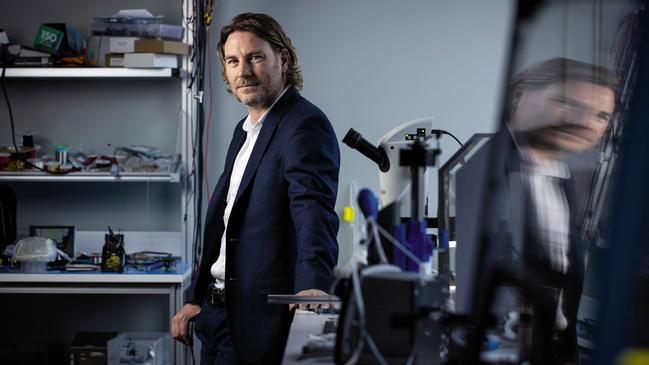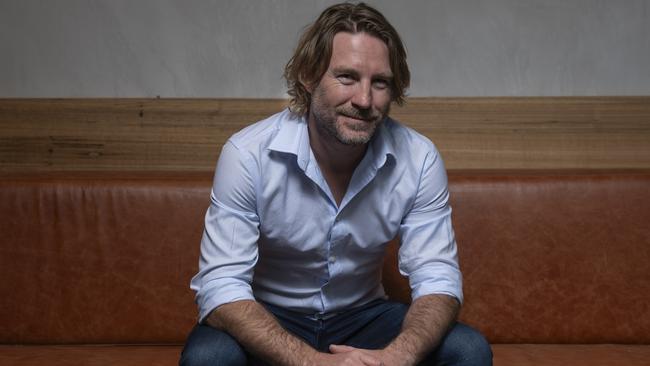Chipping away at the mysteries of a beautiful mind
Australia’s Nick Opie is at the vanguard of technology that reads brains. Will the Synchron co-founder beat the likes of Elon Musk as the first to release this life-changing tech? It’s likely.

It is rare to find yourself in the company of billionaires – let alone beat one of them at
their own game – but it is now an everyday reality for Melbourne biomedical engineer
Professor Nick Opie.
Opie is at the forefront of developing computer chips for people’s brains, connecting
the mind directly with a computer, and sparking a race that has Bill Gates, Jeff Bezos
and Elon Musk jostling for pole position.
Scientists say the technology has the potential to overcome a range of disabilities
and neurological disorders – from restoring sight and movement lost from paralysis
to treating Parkinson’s disease, epilepsy and depression.
Whether it sounds fantastic or frightening, the ability to read and translate the brain’s
electrical codes and signals is creating the foundations for a new multibillion-dollar
global industry.
Synchron, the company that Opie co-founded and is backed by Gates and Bezos,
likens it to a bluetooth for the brain. It offers patients with paralysis a hands-free
experience to regain independence.
While Musk and his high-profile antics – ranging from space, Twitter (now X) and
beyond – has thrust the technology into the spotlight, it is at Synchron where the
rubber has actually hit the road.
Synchron was the world’s first company to be granted approval from the US Food
and Drug Administration to begin clinical trials on a permanent computer-brain
implant, and enrolled its first patient last year, beating Musk’s Neuralink to that
milestone.
So how does it work? Synchron uses a stent-like implant to line blood vessels, and
there are almost 650km of them in each brain, with electrodes or sensors to
record brain activity and convert that into a digital signal to stream thought into an
iPhone or other smart device.
This allows people with paralysis to perform everyday tasks such as online shopping
and banking, sending text messages or simply turning off a bedroom light.
“We can translate these (brain) signals into switches or clicks,” Opie explains.
“If a patient really wants to use a computer, for example, we can offer them a mouse
click and they can start using the mouse as they would have before they were
paralysed.”
Crucially, the stent-like design avoids the needs for open brain surgery.
But Opie says brain chips were not his first thought when he decided to use his
engineering skills to help restore various human functions.
He began his career working on the bionic eye at the University of Melbourne where
he met Synchron’s co-founder and chief executive, Associate Professor Tom Oxley.

“When I started off many years ago – I’m an engineer, so I like the tech and the
gadgets – I was thinking, ‘oh, let’s make all these amazing arms and exoskeletons,
robotics legs, etc’,” Opie says.
“Don’t get me wrong, I’m sure that’s still on the table. But we have found we can
provide a huge amount of value and benefit to these patients with just simple stuff
that perhaps I didn’t appreciate the value of when starting this journey.”
So far, Synchron’s technology has allowed a father, who has suffered paralysis, to
turn off a TV when he has decided his daughters have had enough screen time.
Another paralysis patient was able to chat with Opie about the footy over WhatsApp.
“All the patients are doing really well,” Opie says.
“I think one of the big things that we've done recently was start connecting to the
folks in the US who are completely locked in; so they're bed bound, assisted
breathing, assisted eating, all those sorts of things. They have a lot of difficulty
communicating or they can't communicate – even with eye trackers or other
technology that’s available, they just can’t use it. So what we've been able to do is
hooking them up to an iPhone.
“There’s a screen that shows what they’re doing on the iPhone, you can put the
iPhone in front of them and they can then do patient reporting so they can send
messages using our system to their carers. The patients can send messages even if
the carers aren't there, creating a huge benefit to them.”
On this score, Synchron has continued a tradition set by Australian industrialist Paul
Murray Trainor, who founded The Nucleus Group in 1965. Nucleus was responsible
for the Cochlear bionic ear, the first cardiac pacemakers, cardiac defibrillators and
dozens of medical technologies in use today, with its staff becoming successful in
their own right forming companies including sleep apnoea giant ResMed.
Opie and his colleagues are now excited about potentially using its implant to
stimulate different areas of the brain to alleviate other conditions.
For instance, if part of the brain is damaged by a stroke, it is like a blockage on
Sydney’s Eastern Distributor, whereby motorists are diverted onto side streets and
other roads to reach their destination.
In the brain, neuroscientists call this neuroplasticity, meaning other parts of the organ
can step up and take over the functions of others that have been damaged through
disease or injury.
“At the moment, we are just focusing on paralysis, but one example of how we could
use it for epilepsy is a seizure recording diary … an implanted device that continually
monitors your brain health and can provide physicians with when you’re having
seizures and how long they last,” Opie says.
“An issue with a lot of seizure diaries at the moment is people can’t remember when
they had one so they might not be reporting them back to clinicians who then use
that information to prescribe medicine.
“Once you can record seizures, you could then start predicting when they’re going to
occur. You can see the brain activity change before it turns into a large seizure …
and, if you get in early enough, you can … provide stimulation to a different part of
the brain to stop the seizure from happening. That’s the long-term goal of a closed
loop neuromodulation.”
Similarly with Parkinson’s disease – if you target a specific area of the brain and
stimulate it, it can stop tremors.
But the brain, the seat of consciousness, remains one of the body’s most mysterious
organs. There are conditions in which chips can alleviate, but scientists and doctors
are yet to understand how it works.
“It’s an interesting time in medicine with the technology sort of giving us the answers
to questions we haven’t really thought of yet,” Opie says.
“With depression, how that works, everyone is still looking at it. You put stimulation in
and it seems to work for a lot of people but it’s still unclear on the physiological
pathways of why that’s occurring.”
Synchron has raised $220m to date to develop the technology. Early funding
came from the US Defense Advanced Research Projects Agency, which has a
significant brain program. Other recent investors include US venture capital group
ARCH Venture Partners, Microsoft founder Bill Gates’ private venture fund Gates
Frontier, and Amazon founder Jeff Bezos’ family office Bezos Expeditions.
The List: Top 100 Innovators 2023 launches online and in The Australian on Friday, September 15. It is a celebration of Australia’s boundary pushers and fierce innovators.


To join the conversation, please log in. Don't have an account? Register
Join the conversation, you are commenting as Logout